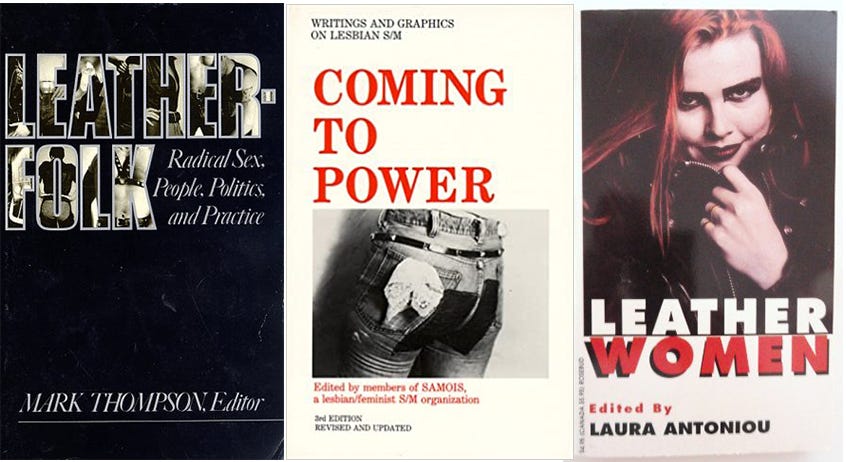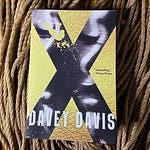CW: Sexual and physical assault, and descriptions of heterosexuality.
My copy of Leatherfolk edited by Mark Thompson is stained with tears, I hid my wet eyes from fellow passengers on the A train as I devoured it on my way to work. So many pieces in that collection really touched on the emotional facets of leather and illuminated all the ways that queer love pushed to the margins can bring us all closer together. Leather is sexy, yes, but it is also tender and it is nothing without community. I remember when my ex-girlfriend gifted me a copy of Coming to Power, the coveted and very out of print Samois leatherdyke anthology. I was ecstatic as I knew this book held so much significance to my erotic lineage. I furiously took notes and read and reread my favorite passages. Another ex gifted me a tattered copy of Leather Women edited by Laura Antoniou, its well-loved pages imbued with the energy of others like me who came before. I kept it in the little cubby next to my bed for years, a talisman to bring forth pleasure and pain. Power Circuits edited by Raven Kaldera includes an essay by Andrea Zanin that was really pivotal for me in understanding that my own ideas of polyamory can work with D/s. Even my Fist zines, five little anthologies of lust and communion, unite experiences of leatherdykes across the globe.
BDSM anthologies are not new. They are some of the most important published work on sexuality, inviting lonely and isolated readers into the erotic worlds of those who dare to live their desires, making plain that another way is possible. All of these books are, for the most part, timeless in connection. They are self-published or published by small presses specializing in themes of sexuality or alternative relationships. This material is surely seen as frivolous by most major publishing companies unless, of course, you’re Dennis Cooper or equally famous enough to convince the publishing gods of smut’s artistic and monetary merit.
Enter Kink: Stories, an anthology just released by Simon & Schuster and edited by Garth Greenwell and R.O. Kwon. I first learned of this anthology from a Leather Associate and was naturally confused why S&S would publish what I thought was going to be a book of kink erotica. Wow, I wondered, is this still the aftershock of Fifty Shades?
On February 9th, its release day, Jade cooked baby beef (a dish with vegan beef named affectionately after Kala) and the pod got comfy on the couch and attended a virtual panel with the two editors and two of the contributors. One of the editors spoke negatively about the commodification of kink without making the connection, at least not out loud, that this book is a major contributor to that phenomenon. The other admitted to not being able to even talk about sex because it’s that level of mortifying. One of the writers said that he didn’t even know what kink was until he was asked to contribute to this anthology, while the other said that kink was all about centering her own desires. The discussion and readings left me dry, confused, and not hopeful at all that the book would actually live up to the hype. Not even three weeks later, Kink has already been named a national bestseller.
The introduction to Kink is really lovely, full of ideas I’ve written and spoken about many times before. It primes the reader for stories that are breaking stereotypes and maybe even setting positive examples of kink as a practice to a very wide audience, something I can get behind! The mainstreaming of kink usually comes filtered by respectability, and this did not sound like that.
Kink is often pathologized in popular culture, the attendant desires flattened, simplified, and turned into a joke, a cause for only shame. In movies, television shows, and popular books, kinky people are often also serial killers, emotionally stunted plutocrats, and other stock villains or exaggerated figures of fun. Instead of pathologizing kink, the stories in this anthology treat it as a complex, psychologically rich act of communication. Kink in these stories is a way of processing trauma, and also of processing joy, of expressing tenderness and cruelty and affection and play. The emotional dynamics of kink are as varied as those of any other human experience, and the stories here explore the whole gamut of human feeling, from exuberance to anguish. Rejecting reductive ideas of normalcy and aberrance, these stories allow for investigations richer than etiology, treating kink as one of the tools we use to make sense of our lives.
Unfortunately, most of these lovely ideas were directly contradicted throughout the themes that wove most of the stories together, kink not being one of them. Not only are several of the stories in this anthology not about kink, they’re not even about sex. Confusing, I know. Most of the stories that do include kink and/or sex left me angered by what I felt was a lack of congruence between the introduction and the words on the pages. If I wasn’t already a very well versed practitioner of BDSM, a professional even, I would walk away from this collection thinking the following: kink is assault, kink is not negotiated, kink is shameful, kink is not done with people you love, both parties involved in a kinky encounter don’t need to be into it, consent is not necessary, vanilla sex is kinky if you’re queer, and kink is a way of avoiding intimacy.
“‘There’s something a little wrong with me…I don’t want to be this way,’ she said, turning toward him her pale, determined face. ‘I’d rather not be this fucked up.’” R.O. Kwon’s story “Safeword” features a husband who, after years of marriage, gets his wife to admit she is not sexually satisfied because she has unfulfilled masochistic desires of which she is very ashamed. He takes his wife to a dominatrix to learn how to beat her (bravo!). He wants his wife to be happy, but he does not want to hit her at all. He hates every second of it. “He didn’t want to hit Jihyun anymore— he wanted to get out of there. He wanted to untie her and take her home, soothe her and have sex with her, his wife, whom he loved. But he kept going.” The wife thinks something is wrong with her and is extremely ashamed, while the husband is straight up not having a good time. Sounds hot, right?
Shame, something the editors mention as always connected to kinky desires in mainstream media, pops up over and over again. If kink in popular culture is a cause for only shame, why include so many stories where characters are mired in it? It would be a complete lie to say that kinksters don’t deal with shame, but in specifically calling out that this collection aims to not position kink as shameful, it’s totally missing the mark. Alexander Chee’s story “Best Friendster Date Ever” has characters who have pretty standard gay sex with some light bondage and say things like “None of my friends know me like this,” and “When I had sex with people I didn’t know, I became someone I only met when I had sex with strangers. I found that the people I met like this often loved it but hated me for doing it, for knowing it about them afterward… There was the rich shame and the defiant pleasure.” Here we see more shame, but this also touches on another theme—kink is most often done with people you don’t know, almost as a way of avoiding intimacy.
Cruising is a cultural norm with both roots deeply planted in BDSM and queer culture. While cruising is great, casual encounters are always at the forefront of mainstream portrayals of kink adding to its cold and pathological social aura. The movie Cruising immediately comes to mind, Angels in America is another. People emotionally invested in kink as a lifestyle usually don’t go from casual SM hookup to casual SM hookup. Kinky people build community and relationships, even family. In Kink, and perhaps also in real life, casual encounters are easier when desires are shameful. When kink is used to ward off true intimacy it is rendered other and distant, which stunts the beauty of its exploration. There is nothing wrong with wanting a stranger to destroy you, to make you nothing, to fill the void. But when this is presented as the dominant option, it’s doing a disservice to the work the editors claim to care about in the intro. The mean and hard Dominant is a mostly incorrect cultural trope, and it’s the reason that people are shocked to find I’m actually a sweet and warm person.
Using kink to avoid intimacy shows up across many of the stories in Kink. Some of them highlight that kink is not something you could ever do with a real partner, thus cruising. Others, like Larissa Pham’s “Trust,” position kink as a distraction, a way to feel intensity without being truly vulnerable. “Trust” is a somber story about a woman in a newish relationship with a man who’s only appeal is that he’s willing to hurt her. She plays to his willingness and stokes his sadistic flames, she feels that becoming the object of his aggression is easier than the thing she really wants—real intimacy. “She knows that a small, soft animal lives inside her, and that that animal wants to be loved completely, flat on its back, kissed and cuddled… But at any touch of softness, a wall goes up in her that she cannot navigate around. Fuck me harder, she says. Easy to be like this, hard. And he listens.”
Roxanne Gay’s “Reach,” actually gay, shameless, SM erotica (and probably my favorite story), features a married couple who practice sadomasochism. It seems to be embedded in their relationship happily from both parties, which is a refreshing perspective I’ve mentioned is lacking in the book. While they have been together for a long time, the protagonist says several times that her wife is hiding things, she has secrets, stories of scars she won’t reveal. “I want to know the stories of all her scars, but I’m not sure I’m willing to pay the price for that knowledge. Sasha continues to stare at my reflection. She is an expert at holding a gaze. She won’t break—not for anything. She’s that way about many things.” SM is portrayed as a game of chess between top and bottom, wife and wife, as a tool to eventually lead to real intimacy. “I will help her up, carry her to bed, hoping I have inched closer to that place she might never let me reach.”
This story touches on another theme, which is lack of consent, communication, and safety. The protagonist casually cuts her wife with a straight razor, hands still sandy from the beach, across her back (err, spine?) without a word between them. Believe me, I understand there is trust in long term SM relationships where you no longer need to ask before you do everything. However, as someone who cuts my partners often enough, there would never be a time where I pick up a dirty(?) straight razor, cut across someone’s spine, not sanitize the skin, or with dirty hands. Whatever enjoyment I was getting out of this story, because it was getting hot, was completely depleted when the cutting scene happened. Call me a buzzkill, but careless bloodplay does not turn me on!
There are countless instances throughout the book where communication and consent should have been given. In fact, most of the stories that involve more than a sentence of sex have no negotiation nor explicit consent. There’s a scene in “Trust” where the woman’s boyfriend cums inside her without a condom and without consent and she thinks to herself “at least I have an IUD.” The fact is that even vanilla sex needs consent and negotiation, which is not the message you get when you read kink scenes where people are diving right in without talking about anything first. I know what you’re thinking, “But I don’t want to read about negotiation in erotica, it will kill my boner!” I think that first of all, negotiation can be really hot if you write it correctly. Even just affirmative consent would be lovely, acknowledging that you already ironed out all the details...anything. Second of all, this book is absolutely not erotica. If Garth Greenwell can take the time to explain to us novices, mid-scene, why emasculation is a turn on (“it’s the worst thing, to seem like a woman”) then we can have some goddamn scene communication!
Melissa Febos opens the book with a story called “The Cure.” If I didn’t know any better, I’d think this was a story about a lesbian written by a homophobic straight woman (the author is actually queer). The protagonist laments she is tired of the lesbian way, which is apparently going on dates with women you’re not even attracted to. She decides to fuck a man because lesbians are too complicated and, let me tell you, what the world needs is a story called “The Cure” about a lesbian fucking a cishet man. While having sex with this man, she immediately decides that she doesn’t want to have sex with this man, but keeps going anyway. Through each encounter they have, she becomes more comfortable with centering what she wants, all without any discussion at all. She turns their last hook-up vaguely kinky by instructing him to jerk off and then telling him to stop so he becomes frustrated. Again, none of these several sexual encounters had any communication or negotiation at all, which maybe was the whole point? I could have also been too horrified and completely missed the point.
Consent is paramount to kink, even the vanillas know that! Apparently when the book came out, some people were upset at the editors on Twitter because kink is often used as an excuse for people, like Marilyn Manson, to abuse their partners. R.O. Kwon published this piece last week taking a stand against the conflation of kink and abuse in an attempt to clear up any misunderstanding. I read that article and Greenwell’s supportive tweet just a few days before I read the anthology.
If kink isn’t abuse (and it is not!), and it’s actually homo/transphobic to say so, then why is the story he included in the anthology a homosexual SM encounter turned violent rape scene? Let’s try to follow this logic. You’re an editor of a soon-to-be bestselling mainstream kink anthology where you introduce the book with a strong view opposing the stereotypes of kinky people in pop culture as serial killers and villains. Does it seem like a good idea to then include a legit Dom-turned-rapist story in your anthology? Yes, we’ve all seen Cruising. Kink is not abuse, and sexual assault doesn’t belong in the same category, or book, as BDSM.
Carmen Maria Machado’s story was a confusing one. It’s a great story standing alone, but I struggled to understand why it was in this anthology when the only vaguely kinky action also turns to physical assault. A woman’s boyfriend is hitting her in the distance and we aren’t really told whether or not it’s consensual. Later, we see this same woman crying for help to escape the same boyfriend beating her. Her trying to flee the second time is the only difference in how consent is communicated between these two scenes. Again, I don’t know how I’m supposed to believe the message that kink is not abuse when many stories don’t include consent and two of these stories also include physical/sexual assault.
The reality of mainstreaming kink in this way is that books like this (and Fifty Shades) are going to be a lot of people’s introduction to BDSM and those involved in commodifying kink need to be accountable to that. Mainstreaming kink can’t be done recklessly with bad examples of poor and dangerous consent practices, lack of communication, and reinforcing archaic stereotypes.
The creators of Netflix’s show Bonded received tons of backlash from the sex working community for the irresponsible portrayal of life as a dominatrix. Season 1 was so bad that I had to turn it off after one episode, a show that I should have loved. Luckily, Netflix did the right thing and hired actual sex workers to consult in creating Season 2. Inviting members of the already marginalized sub-culture you’re exploiting to guide the narrative, and pay them, is the very least they could do. Did the editors of Kink have a BDSM sensitivity reader? Did the editors of Kink edit anything at all?
Book reviews are always interesting to read in that they are never really honest. People are afraid of critique. My kinky writer friends wouldn’t take on an honest book review of Kink with a ten foot pole for fear of upsetting one of the many Very Famous contributors. What if they need one of them to blurb a future book? It’s been so interesting watching people with platforms who don’t normally talk about BDSM join in on this conversation (contributors included). This is to say that many of the reviews I read actually praise the book and confirm that it is, in fact, kinky. The New York Times review says that it “is not quite erotica. Ostensibly, it’s more about the transformative nature of kink as a practice, and the different modalities — kink as anticipation, as communication, as processing…” I’m left wondering if we read the same book. The Cut’s podcast review poses the question, “Well, isn’t everyone just a little bit kinky?” Not everyone posts their entire kinky lives on the internet like me, but it’s not hard to tell by observation of language who is speaking from experience, and who is just speaking.
There are many conclusions that I could draw. It’s annoying when a subculture is misrepresented in mainstream media, commodified kink is never going to be good. It sucks that leather people aren’t included in discussions about their lifestyle. It’s unfair that a group of famous writers could so easily publish a mediocre book “about kink” that isn’t really kinky while my less famous writer friends who are into Leather could not get the same opportunity to do it right, joining the ranks of Leatherfolk and Coming to Power. And lastly, it really sucks that the way this book has been hyped up for weeks led me to believe it was going to be something else entirely.
Amidst a sea of grim disappointment, the book is closed with a story that left me feeling like someone might actually get it? So I leave you with this passage I really liked from Chris Kraus’ story titled “Emotional Technologies.” “This is pure romance, as in roman, a story that’s contained within itself. Like theater or pure math, S/m is a self-generating system large enough to reference everything that it excludes. Romance, desire, context, expectation loop back and forth between us through our roles. Multiple paradoxes yielding triple penetration. The game is totally complete within itself. Unlike ordinary sex, it is an act, and not a metaphor, of love.”















Share this post